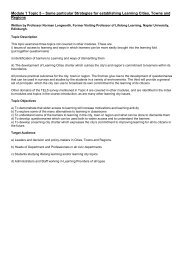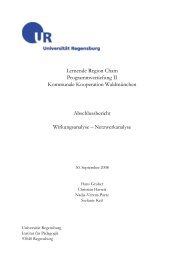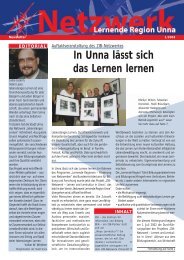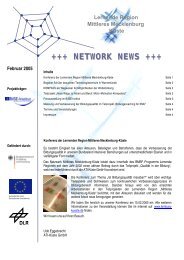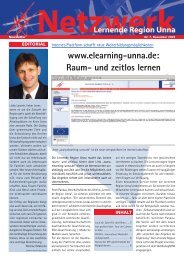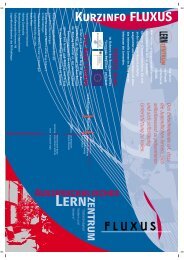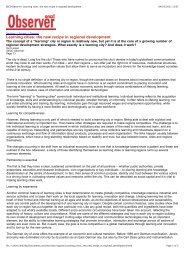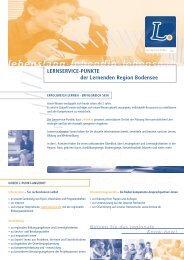SWOT-analysis as a basis for regional strategies - EUROlocal
SWOT-analysis as a basis for regional strategies - EUROlocal
SWOT-analysis as a basis for regional strategies - EUROlocal
You also want an ePaper? Increase the reach of your titles
YUMPU automatically turns print PDFs into web optimized ePapers that Google loves.
hesion through in<strong>for</strong>mation exchange and networking. Activities are particularly<br />
aimed at regions whose development is lagging behind and those<br />
undergoing conversion. The whole of the Union area is eligible <strong>for</strong> activities<br />
within this strand.<br />
The Commission guidelines <strong>for</strong> Interreg III (Communication from the Commission to<br />
the Member States 2000/C 143/08) do not provide any further indication <strong>as</strong> to the<br />
<strong>for</strong>m and function of <strong>SWOT</strong> <strong>analysis</strong>. The Commission working papers on ex-ante<br />
evaluation (‘The New Programming Period 2000-2006: Methodological Working<br />
Papers, no 7 – Strand A and part two – Strand B, 25 July 2000), however, state clearly<br />
that in the c<strong>as</strong>e of Interreg programmes a key element of the ex-ante evaluation is an<br />
appraisal of the <strong>analysis</strong> of strengths, weaknesses and potential of the area, including<br />
the appraisal of the prevailing situation (in particular socio-economic situation,<br />
characteristics and specific needs of the area). This appraisal, furthermore, should<br />
prioritise the opportunities and challenges of the future together with lessons drawn<br />
from the p<strong>as</strong>t. Thus it can be argued that <strong>SWOT</strong> <strong>analysis</strong> h<strong>as</strong> played a relatively<br />
important role in the ex-ante evaluation of the programmes.<br />
1.2 <strong>SWOT</strong> <strong>as</strong> a decision-support system<br />
The <strong>SWOT</strong> <strong>analysis</strong> approach (also referred to <strong>as</strong> the “design school model”;<br />
Mintzberg 1994, 36-39) seeks to address the question of strategy <strong>for</strong>mation from a<br />
two-fold perspective: from an external appraisal (of threats and opportunities in an<br />
environment) and from an internal appraisal (of strengths and weaknesses in an<br />
organisation). The two perspectives can be differentiated by the different degree of<br />
control attainable within each. The dynamic and unrestricted nature of the external<br />
environment can seriously hamper the process of detailed strategic planning, whilst<br />
internal factors are – or at le<strong>as</strong>t should be – more e<strong>as</strong>ily manageable <strong>for</strong> the<br />
organisational entity in question.<br />
The model originally stems from the business management literature, where such an<br />
<strong>analysis</strong> h<strong>as</strong> a clearly identifiable, strategic goal, <strong>as</strong> it is intended to shed light on<br />
outside opportunities and threats that can affect the future of a business, thereby<br />
suggesting some possible remedial actions that might be appropriate in certain<br />
circumstances. The internal <strong>analysis</strong> of a company’s strengths and weaknesses is in<br />
turn intended to highlight certain <strong>strategies</strong> that the company can exploit, in particular,<br />
drawing attention to certain practices that the company may need to correct. (Kotler<br />
1988: 80.) Analogous to this business strategy, public institutions may also use a<br />
similar method to outline the internal and external factors relevant to their strategic<br />
planning process. During the 1980s, public administration embraced this cl<strong>as</strong>sical<br />
model of strategic planning, adopting the b<strong>as</strong>ic managerial model across such are<strong>as</strong> <strong>as</strong><br />
<strong>regional</strong> development and municipal planning (Sotarauta & Linnamaa 1997: 75,<br />
European Commission 1999, Bryson and Roaring 1987).<br />
The four elements of a <strong>SWOT</strong> <strong>analysis</strong> undertaken <strong>as</strong> part of a wider strategic<br />
planning are presented in the following table.<br />
15



